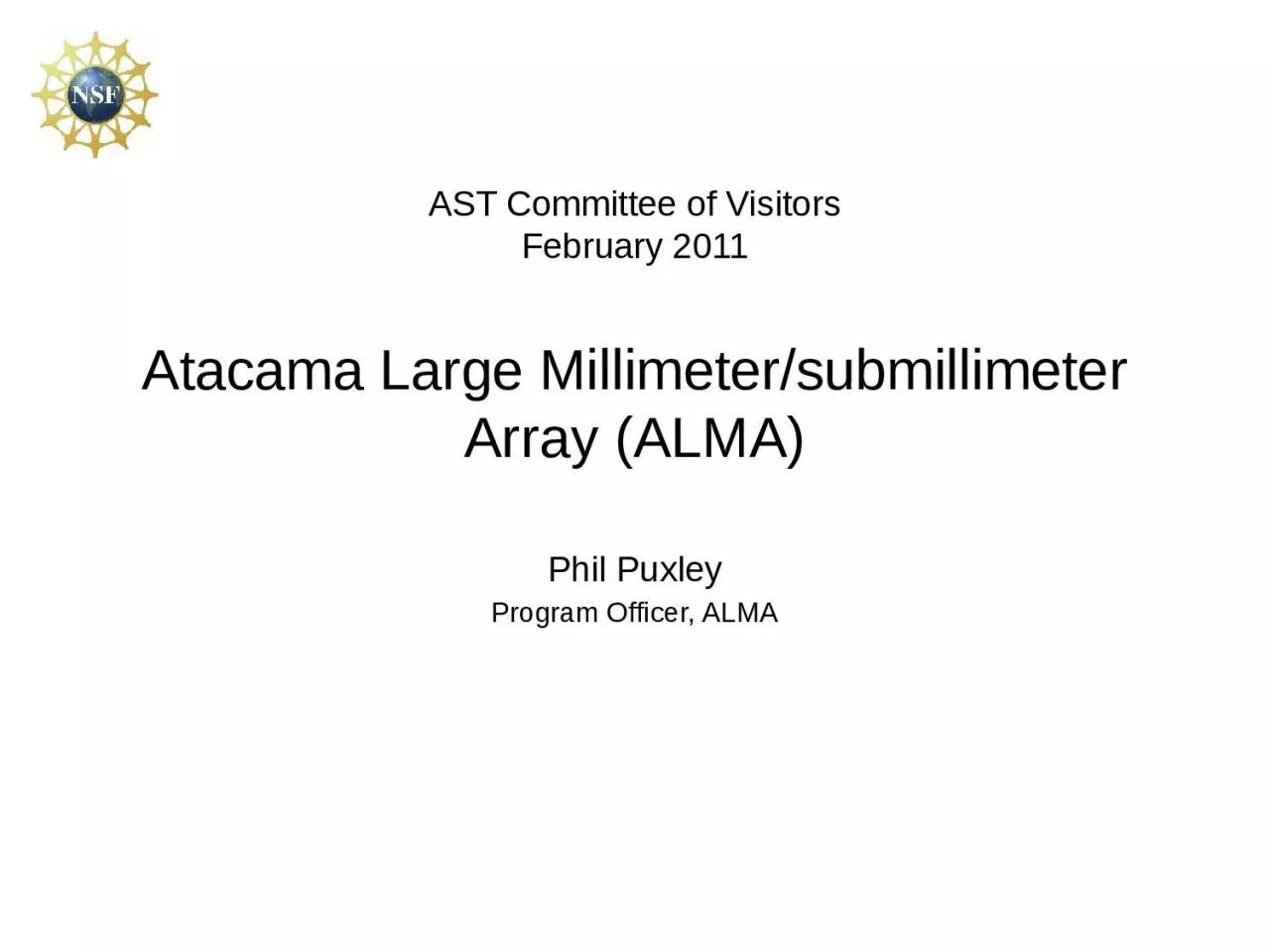

February 2011 Atacama Large Millimetersubmillimeter Array ALMA Phil Puxley Program Officer ALMA ALMA Science Toplevel science objectives Image the redshifted dust continuum emission from evolving galaxies as early as 500Myr after the Big Bang z10 ID: 1029664
Download Presentation The PPT/PDF document "AST Committee of Visitors" is the property of its rightful owner. Permission is granted to download and print the materials on this web site for personal, non-commercial use only, and to display it on your personal computer provided you do not modify the materials and that you retain all copyright notices contained in the materials. By downloading content from our website, you accept the terms of this agreement.
1. AST Committee of VisitorsFebruary 2011Atacama Large Millimeter/submillimeter Array (ALMA)Phil PuxleyProgram Officer, ALMA
2. ALMA ScienceTop-level science objectives:Image the redshifted dust- continuum emission from evolving galaxies as early as 500Myr after the Big Bang (z~10).Determine the chemical composition and dynamics of star-forming gas in normal galaxies like the Milky Way but ¾ of the way across the Universe (z~3).Measure the gas kinematics in young disks in nearby molecular clouds and detect the tidal gaps induced by planet formation.2
3. What is ALMA?$1.3 billion international partnership“North America” (NSF/AUI/NRAO, Canada/HIA and Taiwan/NSC)Europe (ESO)“East Asia” (Japan/NAOJ and Taiwan/ASIAA)To build and operate:At least 50 x 12m telescopes with 4 receiver bands from NA and ESO4 x 12m and 12 x 7m telescopes in a compact formation, plus 3 receiver bands, from EASituated at 5100m on the Chajnantor plain in Northern Chile3
4. 4ALMA Management and OrganizationInternational agreements establish the partnership and roles of ALMA Board and regional ExecutivesBilateral NSF-ESO agreement amended in 2006 and 2007…Japan contributions finalized; NSF-ESO-NINS agreement amended in 2006 …In North AmericaNSF is lead agencyAUI is NA Executive, manages NRAO as lead NA institutionIn Chile, the Executives form the Joint ALMA ObservatoryJAO is not a separate legal entityAUI is employer of all Chilean staffJAO matrix-manages construction and operations staff from ExecutivesNot shown: Directors Council, IPTs
5. 5ALMA Program Management at NSFNSF holds seat on ALMA Board and appoints other US membersALMA Management Advisory Committee, conducts ALMA Annual External ReviewFive NA members appointed by NSFConsultation with NSF LFP, ALMA PAT, CanadaALMA Science Advisory CommitteeFive NA members appointed by NSFRecommended by NRAO, also serve on ANASACNSF programmatic and managerial oversight:NSF/AST Program Officer responsible for Programmatic Management of construction and operationsPO supported by Project Advisory Team (MPS, BFA, OGC, OISE, OLPA and LFP)Large Facility Project division and MREFC panelNA construction and operations embedded in NRAO; oversight coordinated within AST
6. 6Program Management ActivitiesNSF member of ALMA BoardAnnually, 2 face-to-face meetings and ~7 intervening telecons (and NA caucus meetings…); Budget and Personnel subcommitteesAnnual budget material preparation and maintenanceDaily-weekly discussions with DDD/AST, ALMA NA, AUI, NRAO, JAO project staffWeekly-monthly discussions with DD/LFP, BFA/Grants & Agreements Officer and others in Project Advisory TeamQuarterly PAT meetingsMonthly ALMA NA progress reports and face-to-face meetingsMonthly reports to DD LFP (and NSF Director and others)Monthly discussions with international partnersObserve and interact with AMAC/AAER, ASAC, ANASACSite visits (Chajnantor, Santiago, key vendors e.g. Vertex)Domestic and international reviews: e.g. Operations and Annual External Reviews, coordinated with ALMA Board; AST-led reviewsAnnual program plans and reportsRead and digest material, strategic planning etc.
7. 7ALMA Schedule and Funding (I)Construction and operations co-exist through FY2012Strictly separate budgets (MREFC construction, R&RA ops)Early Science planned to start in 2011, full science in 2013ConstructionProject-wide re-baselining in 2005; bi-lateral array reduced from 64 to 50 antennas and other descopesNSB authorized 45% increase in funding and schedule extension MREFC total funding of $499.26M (TYD)Current spent downfrom $8M/month to $4M/month
8. 8ALMA Schedule and Funding (II)OperationsNSB authorized FY07-FY11 ALMA NA operations profile of $70.52MEstablish NAASC, develop operations plans, train staff, user support documentation, outreach, U.S. share of support for facilities handed over from constructionFrom FY08, funded under separate CSA to the NRAO O&M for budget tracking and managementRenewal proposal for FY12-FY15 externally review in mid-2010, submitted to NSB (Feb 2011)Series of internal project and external reviews in 2010 assessed readiness for Early ScienceCommunity access to (16-antenna) subset of array, (4) frequency bands and observing modesAnnounced in early January: Call for Proposals 31 March, start of Early Science 30 September
9. Construction Status33 antennas in Chile9
10. Construction Statusmm/sub-mm receivers in production10
11. Construction StatusHigh site and mid-level facilities constructed11
12. Construction Status12 Antennas Receivers Integration Final North American deliverables
13. Construction StatusScience commissioning is underway13
14. 14ALMA ChallengesManagement and governance complexityConstructionComplete within budget and schedule and scope constraintsCurrently 81% complete with $22M in contingency (33% of uncommitted budget); cost performance is good but about 5% behind reference scheduleSignificant liens on contingency; after known liens and pending change requests, contingency is reduced to $10M (15%) Demonstrating and maintaining productionPacing items are front-end receivers (near term) and European antennas (to completion)AST is keeping a close eye on performance through reports, site visits and reviewsEncouraged strategic use of contingency to limit exposure to schedule risk
15. ALMA ChallengesReview identified principal issues, risks and challenges asPermanent power supply - settled on multi-fuel turbine plant; factory testing completed; installation of 23kV distribution system underwayPower and maintenance costs - will review updated ALMA Operations Plan with international partners and assess Chile vs NAASC budget allocation Risk assessment - AUI/NRAO responded with a comprehensive Risk Management Plan. Principal risks are construction delays, staffing and resource contention, power costs, data (re-)processing capacity. Will assess risk status periodically and review annually.Complex partnership - commitment to continue to further improve processes and relations at all levels (agency, Board, Executives, ARCs, IPTs) Management of expectation in Early Science - announcement of ES has been carefully controlled. Priority is completing construction.Education and outreach Strategic Plan - AUI/NRAO produced responsive plan. Implementation will be reviewed annually.15
16. 16Material Available to COV2008, 2009, 2010 Annual External Review reports and responses2010 NSF operations review, response and Program Officer’s analysis2010 NSF/ESO review of AUI’s Chilean labor management2009 NSF review of schedule and spacing items2008 external safety reviewAUI/NRAO and Program Officer’s monthly reportsAnnual ReportsProgram Plans…please ask for anything else you would like.
17. 17Backup Slides
18. 18
19. 19